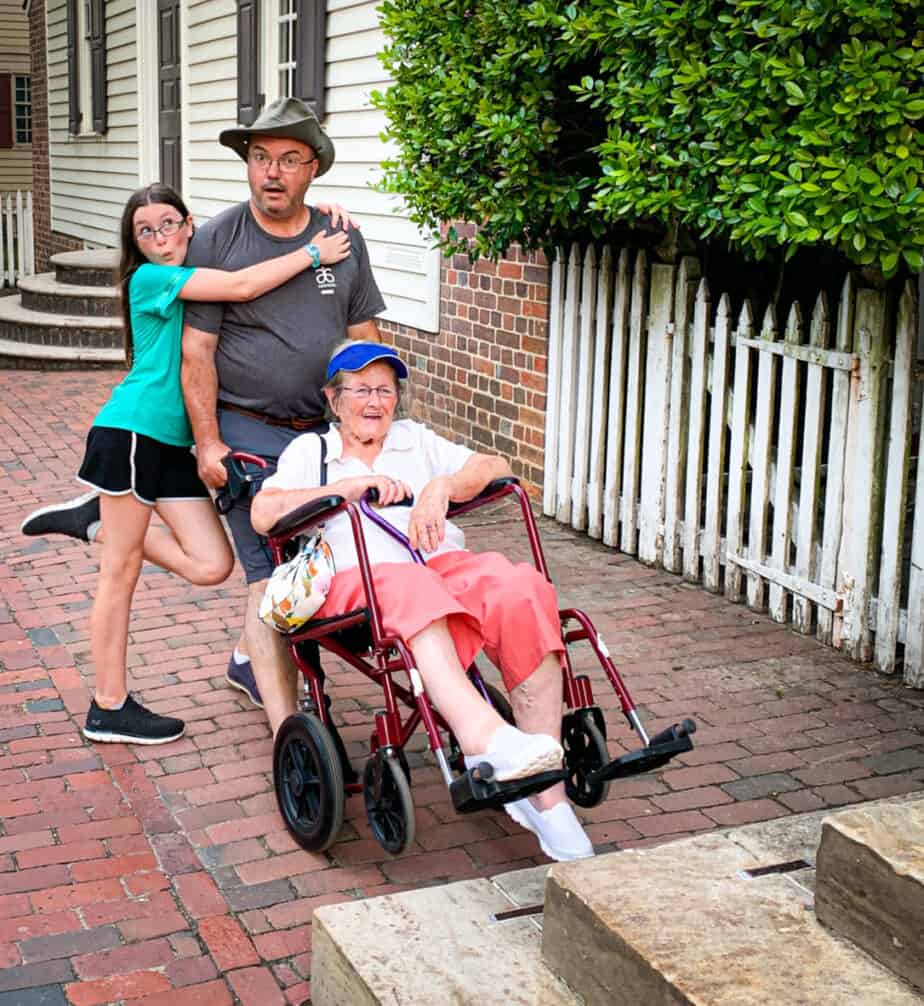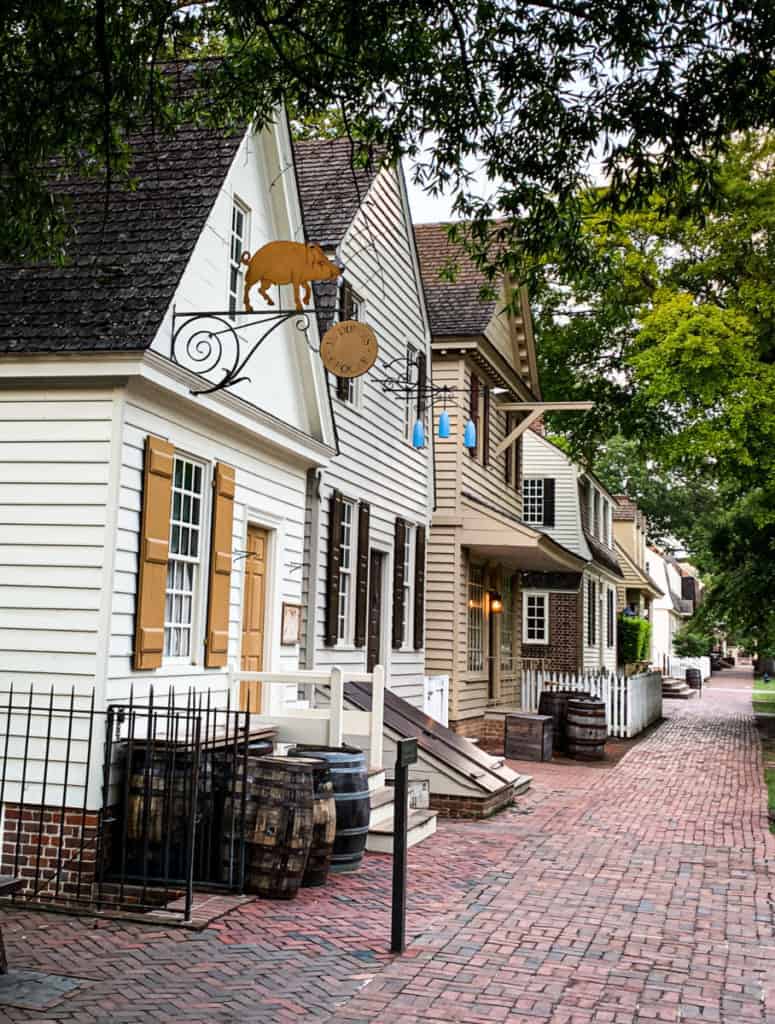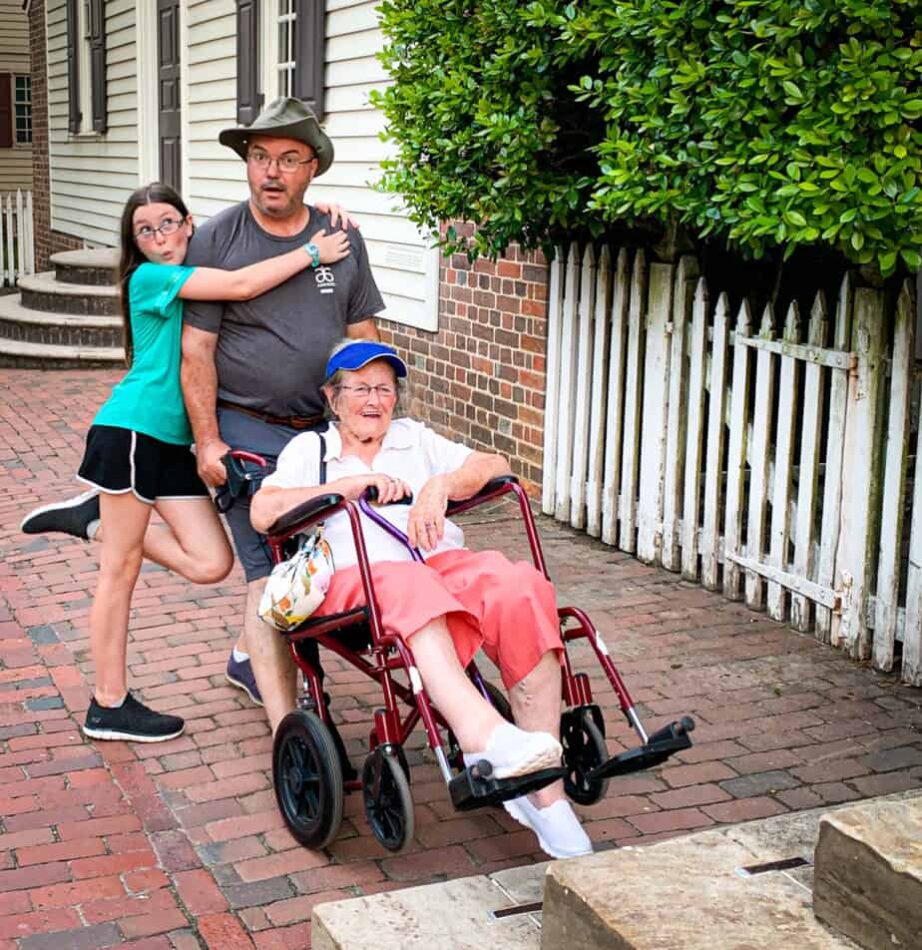This post may contain affiliate links and we may earn compensation when you click on the links at no additional cost to you.

After returning from an awesome visit to Colonial Williamsburg with my 91 year old mom, many people have approached me with the same question.
How do you visit Colonial Williamsburg with an elderly parent who has impaired mobility?
- 1. With a little planning ahead, you can know exactly which places you can go into, and which will only be seen from
outside or the bottom floor.
- 2. the GREAT news is that the entry tickets for persons with mobility impairments are discounted by 50%, so you don’t have to feel that the ticket price doesn’t reflect the fact that you won’t see and do absolutely everything.
On my recent trip with my family, it seemed at first that it was going to be really tricky to navigate this historical site with a wheelchair, my elderly mom, a toddler
Which Activities to Choose For your Elderly Guest with Mobility Impairment
First, you can browse through the lists of activities at Colonial Williamsburg online beforehand right here on their official
This information can also be viewed on Colonial Williamsburg’s free Mobile App on your phone while you’re visiting. The app will have the day’s list of activities with their times and location, a map, and other useful pages, so be sure to download it.
Most activities do require a ticket to access, and are SO very worth the purchase if you are staying a full day, e
The most important thing to do when you first arrive is to go to the Visitor’s Center and ask for their free printed Accessibility Guide!
It will show you ALL the places and activities you can roll into on the map! Unfortunately, they no longer have their handy online PDF version to see before you get there. Instead, they have added wheelchair icons to their website. It’s a bit unsatisfactory, but happily, you can still receive the printed version at the Visitor’s Center. It will have a large map with all the accessible locations clearly marked, as well as accessible bathrooms marked.
Do keep in mind that there will be A LOT of walking and rolling! Even if you have the option of strolling with crutches, or walking with a cane, consider bringing the wheelchair anyway as the historical district is spread out and requires lengthy walks between events.
Williamsburg has made great strides in improving wheelchair access. The first time we came here, for example, there was a lot of sand on the sides of the roads and trails which made it really tough to push a wheelchair through! This time we noticed that a lot of that sand is no longer here, and the roads are much easier to maneuver.

You will notice that the sidewalks are brick and therefore, very bouncy and uneven. Be cautious when navigating the sidewalks!
The road itself is a much smoother option. The only vehicles allowed on it besides pedestrians are horse-drawn carriages, and occasionally, Lafayette will be riding by on his horse!
We carefully maneuvered the sidewalks so we could enjoy close up views of the yards and beautiful gardens that Williamsburg is famous for. I personally love the gardens so much that I bought this large book on the Gardens of Williamsburg for our coffee table many years ago, and love it to this day! Seeing the gardens here never gets old to me and mom.
Some activities that take place on the grass-covered areas could prove more difficult. But Williamsburg is continuously improving its grounds for persons with disabilities.
Free Activities in Colonial Williamsburg for All Ages
A different option, if you are not spending a full day here, is to simply find the free activities available in the historic district. This is what mom and I did on our recent visit, while the more active members of our party chose some of the individually paid activities.
The most enjoyable activity for us was to simply wander the streets, enjoying the costumes and atmosphere of this historical living museum. There are many shops along the wide pedestrian roads that are free to enter for souvenirs and snacks. I sent in my
When we arrived at the Market Square area, we rolled in for some great souvenir shopping!

Just get the times beforehand from the schedule so you don’t miss what goes on here! During holiday seasons, the marketplace is bustling with seasonal gifts and wares for upcoming holidays. Williamsburg is always a very festive place during major holidays.
We contented ourselves with the fife and drum players piping through the town, and an army brigade late in the afternoon, as well as taking the time to grab some colonial-style root beer and some not-so-colonial-style ice cream!
Another place to look for free activities is right next door to the Colonial District, called Merchant’s Square. They have many free concerts, outdoor movies, and festivities all throughout the year. Not to mention fantastic restaurants and shops. You can check their

Most everything in the Merchant Square area is
Where Should I Park for a Person with Mobility Impairment?
Most people start their visit by parking at the free parking lot by the Williamsburg Visitor’s Center. Inside there are gift shops, a bookstore, restaurants, a theater, and accessible bathrooms. Most importantly, this is where you pick up your free copy of the printed Accessibility Guide!
From here you can take the free shuttle bus, which is completely wheelchair-friendly, to the nearby historical district.
We decided to park closer to the actual pedestrian streets and avoid the need for a shuttle. By parking at the end of the Duke of Gloucester Street, in Merchant Square, you are within walking and rolling distance from the
It can be a confusing area to find by GPS, but if you put in the Trellis Restaurant, or the Cheese Shop, you will be directed right to this shopping and dining area at the edge of Colonial Williamsburg.
There is free parking behind the shops, and even in the middle of
Where to Eat in Colonial Williamsburg for Persons with Mobility Impairment
There are a many restaurants and taverns to choose from that are completely wheelchair friendly!
Besides the obvious questions of what type of food and what price range, the first decision to make is whether you want to remain in the historical atmosphere and mood for your dining, or whether you want to return to the modern world to eat.
For colonial dining experiences, these restaurants and taverns are accessible to the mobility impaired visitor:
- Chowning’s Tavern
- King’s Armor
- Raleigh’s Tavern
- Shields Tavern
The menus and descriptions can be found by scrolling down on the official website for Williamsburg, here, as well as the phone number for making reservations, which is also a good way to get the low down on how you’ll be entering their building.
If you are returning to the 21st century for dining, there are some fabulous restaurants right at the end of the pedestrian streets in Merchant’s Square. For a list of their restaurants with phone numbers, you can look here.
I am sure you will find plenty of accessible choices for dining here in the more modern buildings of Merchant’s Square, but all the cafes and restaurants at the Visitor’s Center, the Williamsburg Inn

We really enjoyed the food and atmosphere of The Trellis Bar and Grill. And coffee and snacks at Aromas Café
Related Questions:
Can I Rent a Scooter in Williamsburg?
If you don’t bring your own wheelchair, or decide that the walking will be too much in Colonial Williamsburg, there are several companies that will rent wheelchairs as well as motorized scooters. They even deliver them right to your hotel! One is Williamsburg Mobility, and another is Williamsburg Scooter Rentals which promises delivery to you within 45 minutes.
Is there a Virtual Tour of Colonial Williamsburg?
I was excited to stumble on these 3D tours after our visit. It’s an ongoing project by the Williamsburg Foundation, and there are plenty of resources you can look through, all available online. I also found some great multimedia items on this nonprofit history website here to enjoy before and after our visit.

Just found this on Williamsburg. Very nice and lots of info. If all goes well Dick and I are planning a river boat trip in November and Williamsburg is one of our stops. They probably havet tours planned for us . But we are not the best walkers so may need to find scooters
So easy to get a scooter! And scooters nowadays have tires all geared to the Williamsburg roads!
Thanks for the great article! I want to take my 89 year old parents to Colonial Williamsburg for 2 days, and your suggestions are very helpful. I think it’s wonderful that you made the effort to include your mother in your trip. My father and mother have gone to CW countless times over the years, but now that they have limited mobility, have declined invitations. After reading your suggestions, I think I could convince them to go and have a great time!
They may find out that they can do less than they used to there, but it is still a completely enjoyable trip for the elderly. We just move slower!